The Carnival of Venice captivates millions with its elaborate masks and vibrant costumes, representing a rich cultural heritage. This festival highlights traditional mask styles like Bauta, Volto, and Columbina, each symbolising anonymity and social equality. Originating in the 13th century, it celebrates Venetian artistry while facing challenges like commercialisation and environmental concerns. Engaging with the local customs enhances the experience, making the Carnival a significant cultural event.
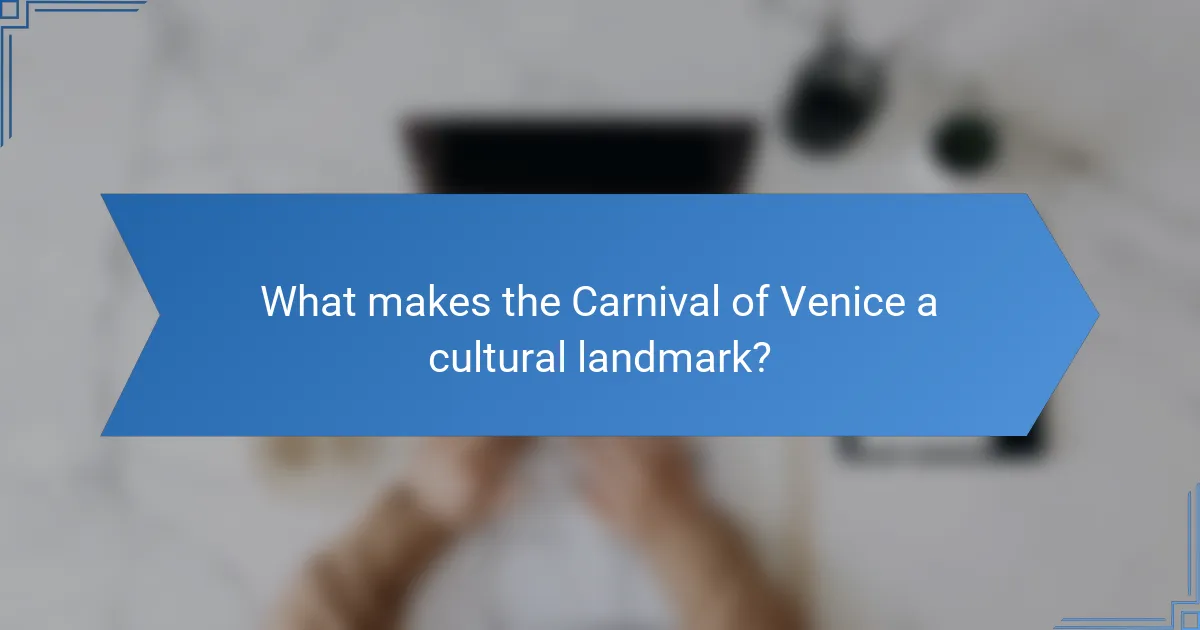
What makes the Carnival of Venice a cultural landmark?
The Carnival of Venice is a cultural landmark due to its rich history, elaborate masks, and vibrant costumes. This festival, dating back to the 12th century, celebrates Venetian traditions and artistry. Masks symbolise anonymity and social equality, allowing people to express freedom. The event attracts millions, showcasing unique attributes like the intricate craftsmanship of masks and the unique performances that highlight Venetian heritage. As a result, the Carnival fosters a sense of community and cultural pride, making it a significant event in global cultural calendars.
How do masks play a vital role in the Carnival’s identity?
Masks are essential to the Carnival of Venice’s identity, symbolising mystery and freedom. They allow wearers to escape social norms and express individuality. The intricate designs and vibrant colours highlight cultural artistry and historical significance. Masks also foster a sense of community, as participants share in the celebration’s traditions and creativity.
Why are costumes significant to the Carnival experience?
Costumes are crucial to the Carnival experience as they embody cultural heritage and artistic expression. They enhance the festive atmosphere, allowing participants to engage in a unique form of social interaction. The elaborate designs and vibrant colours reflect the history and traditions of Venice, making costumes a key element of the celebration. Additionally, wearing masks and costumes promotes anonymity, enabling freedom of expression and creativity. This cultural significance reinforces community bonds and fosters a sense of belonging among participants.
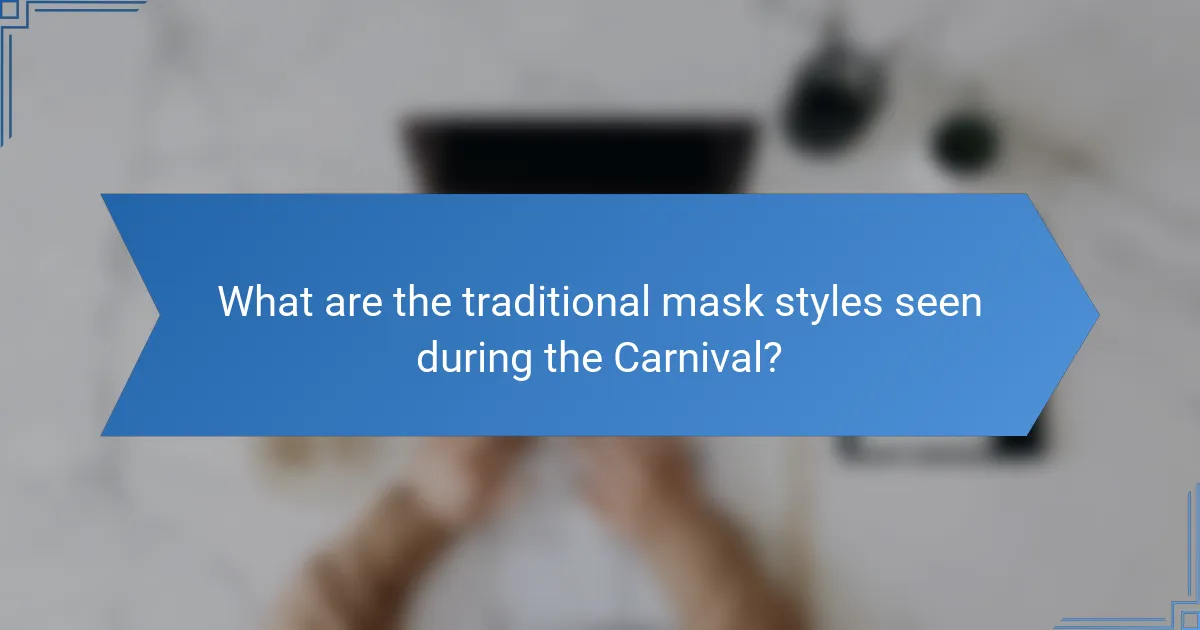
What are the traditional mask styles seen during the Carnival?
Traditional mask styles seen during the Carnival include the Bauta, Volto, and Columbina. The Bauta features a full face covering with a prominent chin, allowing anonymity. The Volto is a simple white mask, often paired with a black cloak, symbolising mystery. The Columbina is a half-mask adorned with feathers and jewels, representing elegance. Each style reflects the rich cultural significance of the Carnival, emphasising themes of disguise and social equality.
Which materials are commonly used in mask-making?
Common materials used in mask-making for the Carnival of Venice include paper mache, leather, and fabric. These materials allow for intricate designs and vibrant colours that reflect the event’s cultural significance.
Paper mache is lightweight and easily shaped, making it ideal for various mask styles. Leather provides durability and a unique texture, while fabric adds richness and versatility in design. Other materials like feathers and beads are often used as embellishments, enhancing the aesthetic appeal of the masks.
How do artisans create unique masks for the Carnival?
Artisans create unique masks for the Carnival of Venice using traditional techniques and materials. They often employ papier-mâché as a base, allowing for intricate designs. Each mask reflects cultural significance, often featuring symbols and colours tied to Venetian history. Artisans may also incorporate rare elements like feathers or gemstones, enhancing the uniqueness of each piece. The craftsmanship involves a deep understanding of aesthetics and functionality, ensuring masks not only look stunning but also fit comfortably.
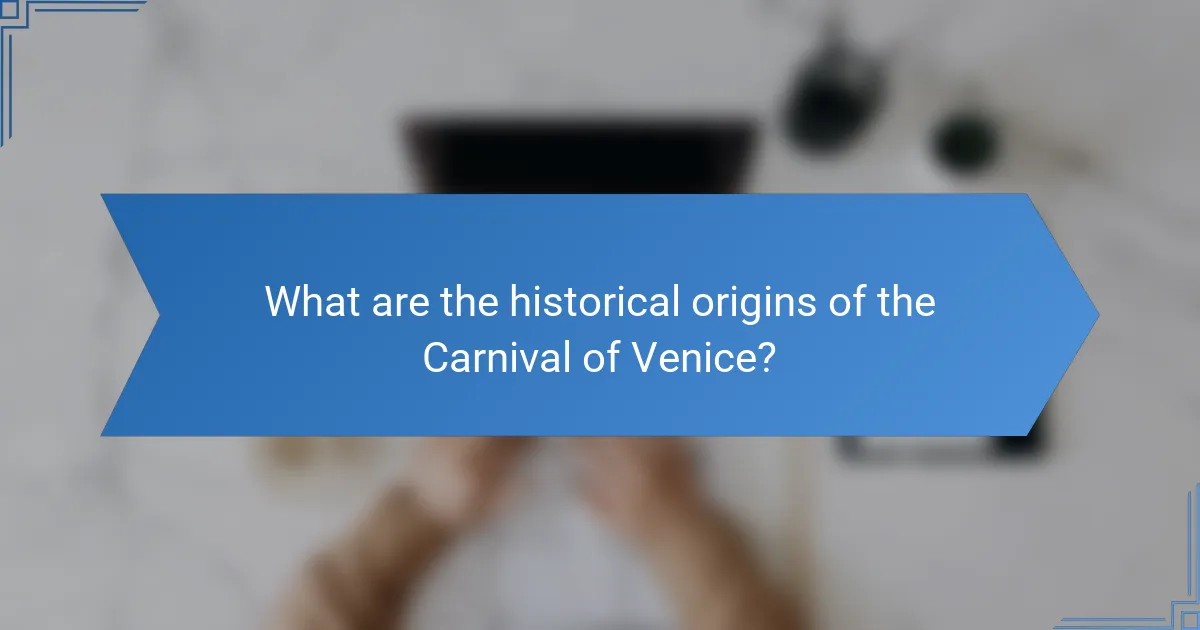
What are the historical origins of the Carnival of Venice?
The Carnival of Venice originated in the 13th century, celebrating the victory of the Serenissima Republic over the Patriarch of Aquileia. This festival became famous for its elaborate masks and costumes, allowing participants to engage in a temporary escape from social norms. The use of masks symbolises anonymity and freedom, fostering a sense of unity among diverse social classes. Over the centuries, the carnival evolved, intertwining with local traditions and cultural practices, making it a significant event in Venetian heritage.
How has the Carnival evolved over the centuries?
The Carnival of Venice has evolved significantly since its origins in the 12th century. Initially, it served as a pre-Lenten festival, allowing citizens to indulge in festivities before the solemnity of Lent. Over time, the use of masks became prominent, symbolising anonymity and social equality among participants.
In the 18th century, the Carnival reached its peak, showcasing elaborate costumes and grand balls. The unique attribute of Venetian masks, often adorned with intricate designs, became a hallmark of the celebration.
The modern Carnival, revived in the late 20th century, emphasises cultural heritage and artistic expression. Events now include parades, competitions, and performances, reflecting both tradition and contemporary creativity. Today, the Carnival attracts millions, highlighting its cultural significance and global appeal.
What role do local legends play in shaping the Carnival’s narrative?
Local legends significantly shape the Carnival of Venice’s narrative by enriching its cultural identity and traditions. These stories often highlight historical events, local heroes, and mythical figures, creating a unique atmosphere during the festivities. For instance, legends about the plague and the masks symbolise themes of anonymity and freedom. Such narratives enhance the emotional connection of participants and spectators, reinforcing a sense of community and continuity. Additionally, they inspire costume designs and mask artistry, further embedding local lore into the Carnival’s visual spectacle.
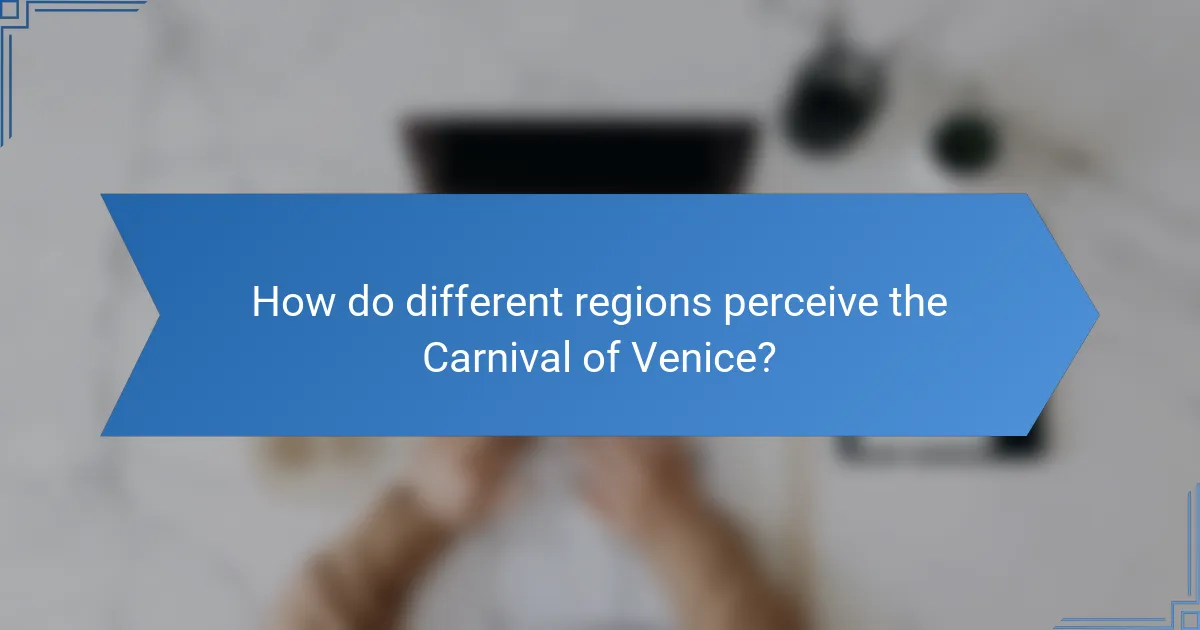
How do different regions perceive the Carnival of Venice?
The Carnival of Venice is perceived as a vibrant celebration of art and culture across different regions. In Italy, it represents a deep historical tradition, emphasising local customs and community engagement. Internationally, it is viewed as a symbol of creativity, attracting tourists who appreciate its elaborate masks and costumes.
In regions like North America, the Carnival is often seen as an exotic festival, celebrated with enthusiasm but lacking the historical context. Conversely, in parts of Europe, it is recognised for its cultural significance, with many attending to experience authentic Venetian heritage.
The unique attribute of the Carnival lies in its intricate mask-making tradition, which varies in style and meaning across different cultures. For example, the masks symbolise anonymity and freedom, resonating with diverse audiences.
Overall, the Carnival of Venice fosters a rich tapestry of interpretations, blending local significance with global admiration.
What are the unique attributes of Venetian masks in various cultures?
Venetian masks possess unique attributes that vary across cultures, often symbolising mystery and social commentary. In Venice, they serve as a means of anonymity and social equality during Carnival. In contrast, other cultures may use masks for spiritual ceremonies or theatrical performances, emphasising their diverse significance. The intricate designs and materials used in Venetian masks highlight artistry, while their historical ties to the plague era showcase a unique attribute of protection and disguise.
How do international visitors experience the Carnival differently?
International visitors experience the Carnival of Venice through unique cultural lenses, enhancing their engagement. They often appreciate the elaborate masks and costumes that signify Venetian history and artistry. Additionally, visitors may participate in exclusive events, such as masked balls, which deepen their cultural immersion. The vibrant atmosphere and historical significance create a memorable experience distinct from local participants.
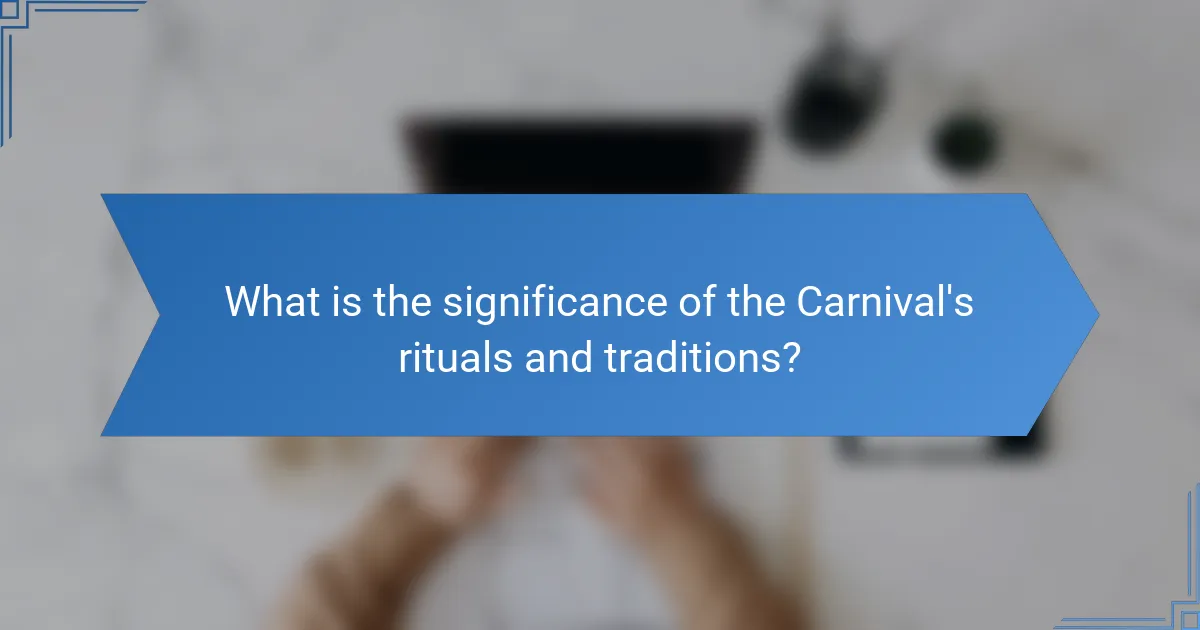
What is the significance of the Carnival’s rituals and traditions?
The Carnival’s rituals and traditions are significant as they embody cultural heritage, artistic expression, and community engagement. Masks serve as symbols of anonymity, allowing social boundaries to dissolve. Costumes reflect historical influences and creativity, showcasing the artistry of local craftsmen. These elements foster a sense of unity and celebration among participants and spectators alike. The Carnival also preserves age-old customs, reinforcing identity and continuity within the Venetian culture, making it a vital cultural event.
How do performances enhance the cultural experience of the Carnival?
Performances significantly enhance the cultural experience of the Carnival by showcasing traditional art forms and community involvement. They create an immersive atmosphere through music, dance, and theatrical displays, reflecting Venice’s rich cultural heritage. The unique attribute of the Carnival lies in its elaborate masks and costumes, which symbolise anonymity and freedom of expression. As a result, performances foster a sense of unity among participants and spectators, making the event a vibrant celebration of Venetian identity.
What are the key events and parades during the Carnival?
The key events and parades during the Carnival of Venice include the Grand Parade, the Flight of the Angel, and the Masquerade Ball. The Grand Parade features elaborate floats and costumes, showcasing Venetian culture. The Flight of the Angel marks the opening of the festivities with a performer descending from the Campanile. The Masquerade Ball offers a luxurious experience where attendees don exquisite masks and costumes, celebrating the rich traditions of the carnival. These events highlight the unique cultural significance of the Carnival of Venice.
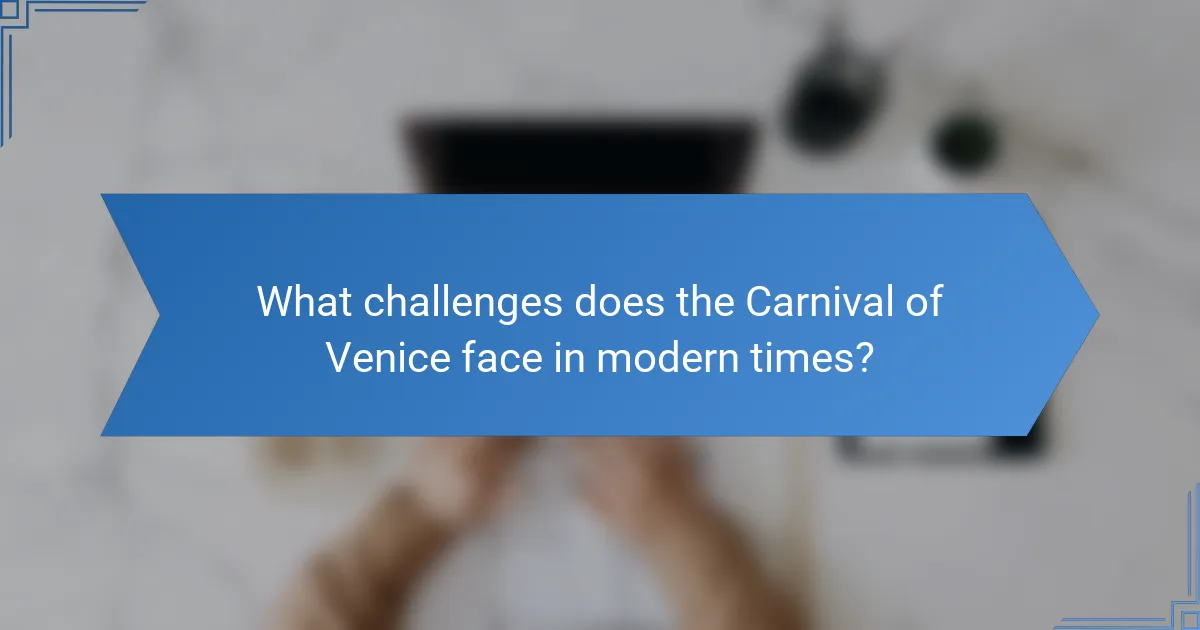
What challenges does the Carnival of Venice face in modern times?
The Carnival of Venice faces challenges like commercialisation, cultural dilution, and environmental concerns. These issues threaten the authenticity and sustainability of this historic celebration.
Commercialisation has led to an influx of tourists and vendors, often overshadowing traditional practices. Cultural dilution occurs as modern influences replace authentic Venetian customs. Additionally, environmental concerns arise from waste and pollution generated during the festivities.
To address these challenges, organisers are emphasising sustainability and preserving cultural heritage. Efforts include promoting local artisans and reducing waste through eco-friendly practices. These initiatives aim to maintain the Carnival’s unique identity while adapting to contemporary issues.
How is sustainability being addressed in Carnival practices?
Sustainability in Carnival practices is increasingly emphasised through eco-friendly materials and local craftsmanship. The Carnival of Venice promotes the use of sustainable fabrics and traditional techniques, reducing environmental impact. This approach not only preserves cultural heritage but also supports local artisans. As a result, the event enhances community engagement and raises awareness about sustainability.
What impact does tourism have on the authenticity of the Carnival?
Tourism significantly impacts the authenticity of the Carnival of Venice by commercialising traditions. Increased visitor numbers lead to a focus on spectacle over cultural heritage. Authenticity can diminish as local customs adapt to tourist expectations. The unique attribute of handcrafted masks is threatened by mass-produced alternatives, altering the Carnival’s cultural significance.

What are the best practices for attending the Carnival of Venice?
To fully enjoy the Carnival of Venice, immerse yourself in its rich traditions and vibrant atmosphere. Dress in elaborate costumes and masks, as they are central to the event’s cultural significance. Plan your visit around key events, such as the Grand Ball and parades, to experience the festivities fully. Arrive early to secure good viewing spots for performances and enjoy the local cuisine, which enhances the festive experience. Engage with locals and fellow visitors to deepen your understanding of this historical celebration.
How can visitors choose the right costumes and masks?
Visitors can choose the right costumes and masks by considering their personal style, the theme of the event, and comfort. Selecting vibrant colours and intricate designs enhances the carnival experience. Researching traditional Venetian styles, such as the Bauta or Colombina masks, can provide inspiration. Additionally, renting costumes allows for variety without a significant investment.
What tips can enhance the overall Carnival experience?
To enhance the overall Carnival experience, immerse yourself in the cultural significance of the event. Engage with local traditions, participate in mask-making workshops, and attend parades to appreciate the artistry. Dressing in elaborate costumes adds to the atmosphere, allowing you to connect with the historical roots of the Carnival of Venice. Prioritise attending events that showcase traditional music and dance, as these elements enrich the festive spirit. Lastly, exploring lesser-known venues can provide unique insights into the celebration, offering a more authentic experience.